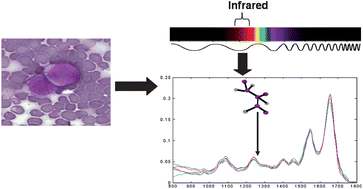Fourier transform infrared spectroscopic studies of T-cell lymphoma, B-cell lymphoid and myeloid leukaemia cell lines
Abstract
This paper presents

* Corresponding authors
a
Biophotonics Research Group, Gloucestershire Hospitals NHS Foundation Trust, Great Western Road, Gloucester, UK
E-mail:
j.babrah@medical-research-centre.com, n.stone@medical-research-centre.com
Fax: +44 (0)8454 225485
Tel: +44 (0)8454 225486
b Department of Haematology, Gloucestershire Hospitals NHS Foundation Trust, Great Western Road, Gloucester, UK
c Department of Histopathology, Gloucestershire Hospitals NHS Foundation Trust, Great Western Road, Gloucester, UK
d Cranfield Health, Cranfield University, Cranfield, UK
This paper presents

 Please wait while we load your content...
Something went wrong. Try again?
Please wait while we load your content...
Something went wrong. Try again?
J. Babrah, K. McCarthy, R. J. Lush, A. D. Rye, C. Bessant and N. Stone, Analyst, 2009, 134, 763 DOI: 10.1039/B807967F
To request permission to reproduce material from this article, please go to the Copyright Clearance Center request page.
If you are an author contributing to an RSC publication, you do not need to request permission provided correct acknowledgement is given.
If you are the author of this article, you do not need to request permission to reproduce figures and diagrams provided correct acknowledgement is given. If you want to reproduce the whole article in a third-party publication (excluding your thesis/dissertation for which permission is not required) please go to the Copyright Clearance Center request page.
Read more about how to correctly acknowledge RSC content.
 Fetching data from CrossRef.
Fetching data from CrossRef.
This may take some time to load.
Loading related content
